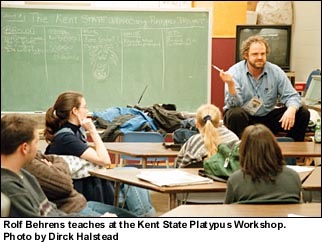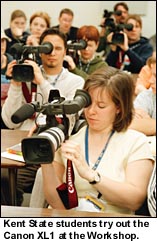|
Video Stories
from the Kent State Platypus Workshop
May 4, 1970 seems light years away from
the millennial students now taking classes at Kent State University. The
history-making killing of four students and wounding of nine in an anti-war
confrontationwith the National Guard that day rumbles as an emotional undercurrent,
a thread of dissent even today.
But what do the millennial students perceive
as the story? Could they visually show their ideas in a video format that
was unfamiliar to most of them? That's the question The Digital Journalist
team sought to answer in its early April visit to Kent State University's
School of Journalism and Mass Communication.
For the past five years, the School has
been revamping its curriculum to emphasize convergence, to teach in multimedia
platforms and to offer students the opportunity to peer into the future
of journalism technology.
The School had been searching for a photojournalist
faculty member who could feel comfortable with videography - a platypus,
by TDJ definition. The faculty didn't know at the front end that that's
the kind of person the School wanted. But after extensive searching, including
the NPPA site, they agreed the School needed a strong photojournalist to
support the print program - along with someone to look to the future. After
all, the university is already pressing the School to define the types
of spaces it will need in five years when it moves across campus to its
new home.
So, when Dirck Halstead pitched the idea
of bringing the Platypus Workshop to Kent, the School's Director Pam Creedon
didn't flinch. She'd agree to have the staff visit with the hope that the
finished videos would find a home on a news outlet through the negotiations
of Halstead. We figured the work would appear on TDJ and also on the Apple
Learning Exchange, a worldwide web network of schools.
Two weeks later, the team arrived with
Halstead, Rolf Behrens as video editor and Dick Swanson as added support.
Instantly, the students were engaged in learning. The 25 had volunteered
to learn video from TDJ staff for five to seven days. Notes were sent to
all the students' faculty across the university asking for excused
absences. Few students balked at the expected full-time commitment to this
type of project.
Faculty support person Barbara Hipsman,
an associate professor with a long background in news, developed
teams led by print photography students. Each team also had one print story
teller, one broadcast story teller and a support electronic media person
as well as one "other" - a younger student generally. Hours passed like
minutes as the students worked to learn the storytelling system of Platypus.
View
the QuickTime Video of Rolf Behrens
teaching
video to Kent State students.
And finally, the staff and teams began
to talk about May 4, 1970. Some teams said they knew a lot. Later, they
would admit to not knowing as much as they had thought. A documentary was
shown about the incident. Resource persons were available. Late nights
brought discussion. The students then were told to come up with a story
about May 4 they thought millennial students might be interested in hearing.
Could
it be something a little different than
what was seen on the airwaves time and time again?
THE VIDEO STORIES
These videos are presented
on the Apple Learning Interchange.
They can be viewed with
Apple's QuickTime Player.
Click
here to download the free QuickTime plug-in from Apple's website.
Project One:
Designing
May 4
When Bridget
Commisso was a ittle girl growing up in Akron, Ohio, Don Drumm was just
the friendly neighbor living across the street.
Little
did she know that in a matter of a few years, she would talk with him about
his artistic presence as a sculptor during one of the must turbulent times
in U.S. History.
Drumm,
a sculptor and craftsmen in Akron, was asked to construct a corten steel
sculpture in front of Taylor Hall on the Kent State University campus in
1967. A bullet hole soon changed what the piece of art would mean to Drumm
and the university.
On May
4, 1970, National Guardsmen arrived on the Kent State campus while students
protested the Vietnam War and the recent invasion of Cambodia. Unfortunately
the guardsmen decided to open fire on the students.
One of
the many bullets fired made its way through Drumm's sculpture and into
a crowd of students. Four students were killed that day and a bullet pierced
Drumm's sculpture changing it's artistic value forever.
Today,
30 years after the tragedy - people are still intrigued by the May 4 shootings
and its historical and human impact on the nation.
The event
led five Kent State students involved in the Platypus multimedia project
to dig deeper and find the story behind the story of Drumm's sculpture
and his reflections on May 4.
With
Bridget Commisso as a photographer and team head; Chris Fulton, an electronic
production major, Carl Matzelle, a news photojournalism major, Jad Melki,
a graduate student and Rachel Wenger, a news
print journalism major, the Brown Team was full of talent and energy.
After
talking intensively with Don Drumm we knew we had found a story that was
both visually and journalistically appealing.
We hope
that you will agree that even though Don Drumm may seem like the guy next
store - his talents and style are certainly welded in Kent State's history
forever.
Drumm team: Bridget
Commisso, Platypus shooter, Chris Fulton, Rachel Wenger, Carl Matzelle,
Jad Melki
|
Project Two:
Maintaining
May 4
Rhonda
Wilson has several subtle yet interesting connections to the May 4 tragedy.
All of them interconnect to form a web of reflection and insight that lenda
fascinating angle to May 4.
Eight
years old at the time of the shootings, Rhonda Wilson was living in the
area and remembers the build up to and culmination of the tragedy.
Now, as a full-time Parking Services employee, she frequently works in
the parking lot where the four students died. Her supervisor was
actually attending Kent when the shootings occurred; he has shared both
his photographs and his memories with Rhonda.
And,
finally, one of Rhonda's classes at Kent is the course specifically dealing
with May 4, taught by Tom Hensley and Jerry Lewis, both of whom were on
campus May 4, 1970.
The student
team's video follows Rhonda through an average day. She works in the Prentice
Hall parking lot, emptying parking meters and performing basic maintenance.
Rhonda
is also seen in class, learning more about May 4, and later, interacting
with her supervisor as he shows her his photos and recalls what he experienced
on May 4, 1970.
The things
that Rhonda has learned and the discoveries that she has made about May
4 become more than just aspects of her own personality. Throughout the
video, as Rhonda "maintains May 4," the impact of the events at Kent State
grow on the viewer in the simple yet powerful way that they have grown
on Rhonda.
Rhonda's
lesson is a basic one, yet ultimately very powerful.
Shane Roach, Veronica Stensrud,
Chris Gianakos, Tim Harrison, Tim Bugansky |
Project Three:
Drawing
May 4 Memories
includes the musings of Chuck
Ayers, cartoonist for the popular strip "Crankshaft."
Ayers and his partner Tom Batiuk started the Crankshaft May 4 story line
just as the teams began to learn to shoot video the first week in April.
They initially shot a storyline with Batiuk, but realized that Ayers was
actually the artist on this strip...and that they needed better shots.
So, they arranged to interview Ayers.
What emerges is a very personal, poignant look into Ayers' history with
Kent State. He talks the viewer through his emotions both from May 4, 1970
and now, as he drew the month-long story line for the strip.
Ayers was a student photographer in 1970. Batiuk also attended Kent.
Team members: Katie Deuel,
videographer, Todd Carson, Michelle Chyatte, Chris Fulton, Rachel Wenger
|
Project Five:
Dad
and Daughter Reflect
He was
one of the Kent Krazies, a group of students adamantly protesting the war
in vietnam and the National Guard's appearance on the Kent State campus.
John Hartzler along with his future wife, twin brother Jeff, and close
friends Alan Canfora, Tom Grace, Jerry Perski, Franky Sedel and Tom Miller
felt the burn of tear gass in their eyes and know the pain of witnessing
the shootings.
Hartzler was a senior education major at the time of the shootings, but
he never graduated from Kent after the university sent him a letter saying
he had rendered himself unfit to be a teacher. Even though, he has always
wanted daughter Emily to receive her higher education at the place where
he had so much fun - and learned so much about the world.
Thirty years later John and Emily will once again be attending the May
4 commemorations. This time, they'll do it together. But for John, he says
this will be his last. John says he does not want what happenedon May 4,
1970 to ever be forgotten. But he says he is tired, and everything needs
a time to rest.
Orange Team: Justin Casalandra,
Platypus shooter, Shane Hoover, Kabir Sanches Bhatia, Dana Pederson, Brenda
Culler |
|

